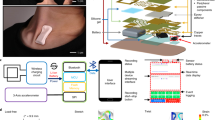Abstract.
A new mandibular sensor is presented here based on the use of a Hall sensor, attached to one mandible, opposite a magnet, attached to the other mandible. Changes in sensor voltage, proportional to magnetic field strength, and thus inter-mandibular angle, are recorded in a logger. This system was tested on seven captive Adélie penguins (Pygoscelis adeliae) and three gentoo penguins (Pygoscelis papua) during: (1) feeding trials on land, where birds were given known quantities and types of food; and (2) trials in water where birds were allowed to swim and dive freely. In addition, six free-living Magellanic penguins (Spheniscus magellanicus) were equipped with the system for single foraging trips. Angular signatures were looked for in instances when both captive and free-living birds might open their beaks, and it was discovered that five major behaviours could be identified: ingestion, breathing, calling, head shaking and preening. Captive feeding trials showed that prey mass could be determined with reasonable accuracy (r 2=0.92), and there was some indication that prey type could be resolved if recording frequency were high enough. Vocalisations in Adélie penguins (arc calls) took <0.7 s for mean maximum beak angles of 4.2° (SD 1.3), and were distinguished by their relatively gradual change in beak angle and by their high degree of symmetry. Beak shakings were distinguishable by their short duration (multiple peaks of <0.5 s) and minimal maximum angle (<0.5°). Preening behaviour was apparent due to multiple decreasing peaks (angles <8°). Breathing could be subdivided into that during porpoising, where a characteristic double peak in beak angle was recorded, and that during normal surface rests between dives. During porpoising, only the primary peak (mean maximum beak angle 25.1°, SD 4.7) occurred when the bird was out of the water (mean maximum for second peak 5.9°, SD 4.1). During normal surface rests in free-living birds, breaths could be distinguished as a series of beak openings and closures, showing variation in amplitude and frequency according to an apparent recovery from the previous dive and preparation for the subsequent dive to come. The mandibular measuring system presented shows considerable promise for elucidating many hitherto intractable aspects of the behaviour of free-living animals.
Similar content being viewed by others
Author information
Authors and Affiliations
Additional information
Electronic Publication
Rights and permissions
About this article
Cite this article
Wilson, .R., Steinfurth, .A., Ropert-Coudert, .Y. et al. Lip-reading in remote subjects: an attempt to quantify and separate ingestion, breathing and vocalisation in free-living animals using penguins as a model. Marine Biology 140, 17–27 (2002). https://doi.org/10.1007/s002270100659
Received:
Accepted:
Issue Date:
DOI: https://doi.org/10.1007/s002270100659




